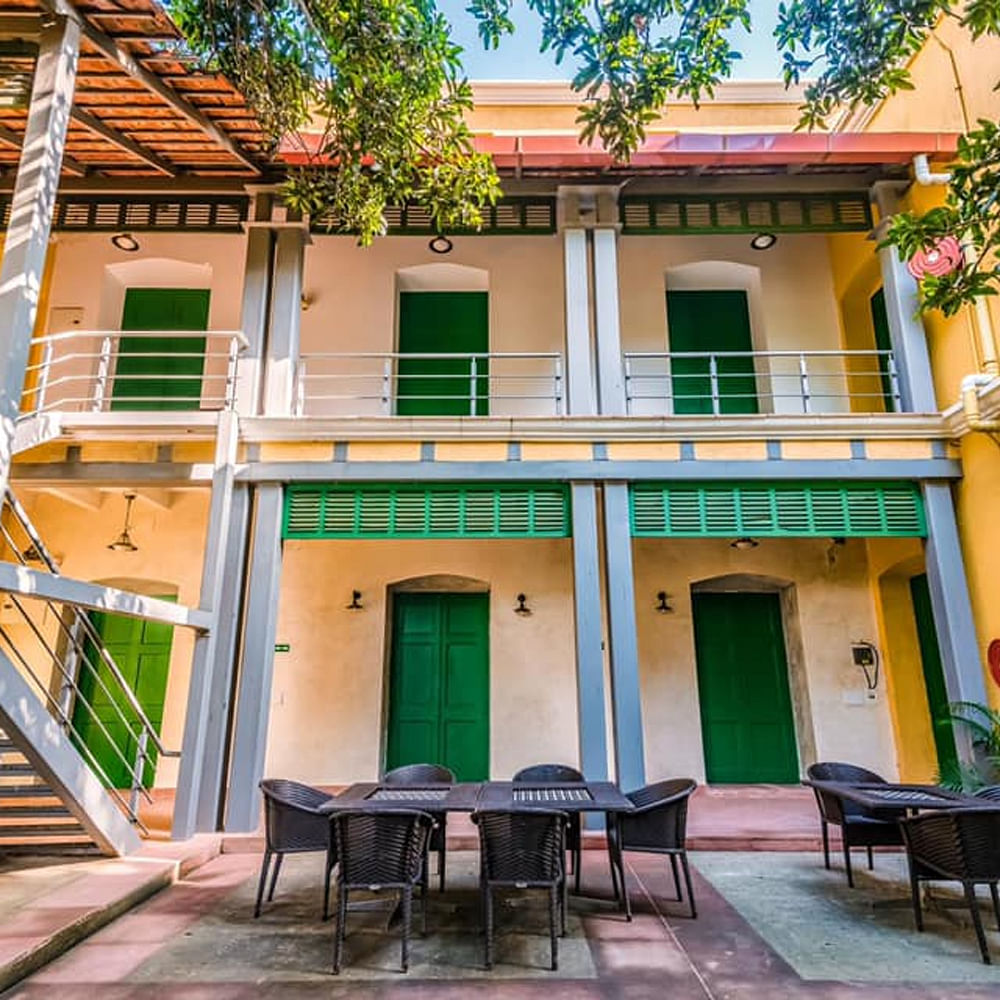West Bengal, before and after independence is never beating the allegations of being the starting point of all things art, patriotism, history, literature and more. And as we speak of that, Serampore or Srirampore as we call it now–a day trip destination from Kolkata, is all about admiring the relics that speak the legacy of Bengal. Sounds intriguing? Here's the only exhaustive guide you will need to explore Serampore.
Serampore: Guide To This Colonial Town That Has Witnessed Bengal's Legacy
What Makes It Awesome
Bengal and Serampore were the first stations established by the Danish trading business in 1698 and 1755, respectively. In reality, they named it after Denmark's King, Frederik the Fifth.
In 1845, the Danish sold Serampore to the Brits. A lot of locals believe that this picturesque village on the Hooghly river bank has colonial roots that date back to the Danish East India Company. Serampore rose to prominence in the 17th century as one of Bengal's most talked-about regions.
They also narrated how Serampore, which resembled the towns of Denmark, was a popular vacation and escape spot for Europeans. Because of its proximity to the Hooghly River, it was a major hub for trade and commerce as well as art. During that time, Serampore was a shining example for the Bengal state. As a result, this day trip location from Kolkata is the ideal way to experience a bit of history up close.
How To Get There
Plan a day trip here as about 30 kilometres separate Serampore and Kolkata.
By car: You can reach here by car as it should take roughly one and a half hours to drive. Drive down the NH19 after crossing the Vidyasagar Setu in the direction of Howrah. After crossing the JSW Steel factory at Dankuni, turn right towards Burdwan. When you see the Serampore signposts, turn right off the highway. Continue driving for a few kilometres until you reach the Serampore town centre, which is lined with residences and businesses.
By train: There are trains that run between Howrah and Serampore. Board at the Howrah Jn station and deboard at Serampore station. Due to its 9 stoppage stations, the total time taken by train is around 33 minutes.
Places To Visit
St Olav Church
One of Serampore's most notable landmarks is the church, which was constructed in 1806. After receiving the UNESCO Asia-Pacific Award of Distinction for Cultural Heritage Conservation in 2016, the church underwent extensive renovation. Even after restoration, the original splendour and spirit have persisted. If the morning mass is already going on when you arrive, given the significance of the ceremony, refrain from taking any pictures because it would be improper.
The monogram of Danish King, Christian the Seventh, can still be found in the chapel. The restoration was carried out in partnership with the National Museum of Denmark's Serampore Initiative, Serampore College and the Diocese of Kolkata.
Serampore Rajbari
The Rajbari, home to the powerful Goswami family, is another must-see. You will not be allowed to enter the housing area that is still inhabited. However, from the outside, the edifice appears to be a symbol of architecture with a splash of Danish magic. One of the town's oldest and most well-known Durga Pujas is held here. At the entryway, you will see a massive building known as the Chandni or Natmandir.
The Goswamis reportedly intended to buy the entire Serampore from the Danish, but they were turned down despite giving a great sum of money. No amount of words can capture the grandeur of this location. People are doing everything in their power to preserve what remains. With more than 100 rooms, it is perhaps the biggest palace in Serampore. The Rajbari has large double arches, a courtyard with fluted columns, and towering pillars at least 30 feet tall. The courtyard is surrounded by stained-glass windows and a running balcony on a higher level.
It's also a popular location for pre-wedding photographs and a well-known wedding site. This site whispers the history of time, and that is its beauty.
Henry Martyn Pagoda
The Peace Pagoda, also called Henry Martin's Pagoda, is located directly behind the Serampore Jolkol. The natural aesthetics of this ruins next to the serene Hooghly river are excellent. The Atachala Temple is a brick structure with a Tri-Khilan porch that faces south. In the 1600s, Rudraram Pandit constructed a temple here and offered it as a home to the idol of Radha Vallabh. Radha Vallabh was positioned in a second temple that Rudraram constructed in order to alter the river's flow.
Reverend Brown purchased this location's huge acreage from nearby landowners in the 1800s. Henry Martin came to this location to worship Lord Jesus. This location was abandoned once the Olav Church was erected. Some of this architecture is said to have been damaged by British gunfire.
Ultimately, it was transformed into the Henry Martyn Pagoda, a chapel and gathering spot in the 18th century. You must exercise caution when traversing the forest. It is advisable to visit during the day.
Serampore College
Serampore College was founded in 1818 by William Carey and other British missionaries, making it one of India's oldest and first colleges. The college grounds are studded with relics of William Carey and his fellow missionaries; the mansion that Carey resided in along with Joshua Marshman and William Ward created India's first printing press for translating the Gospel into native languages, and constructed the vast Serampore College.
The college provides a variety of undergraduate and postgraduate programs and is connected with the University of Calcutta. Serampore College continues to enjoy the prerogative of issuing its own theological degrees under the authority granted by the Serampore College Charter and Act.
The West Bengal Heritage Commission's repair of historic buildings in the area is funded by the National Museum of Denmark's Serampore Initiative. A massive central building with towering ionic pillars is currently designated as a heritage structure. This trio released an extraordinary array of books in several languages, including Chinese, which may be found at the museum. All of them were printed at Serampore Press. Carey's desk and letterbox are still here.
If you’re really lucky, the college administration might let you view the library, which houses many historic books, including a copy of 'Samachar Darpan', the first Bangla magazine ever published.
The Mission Cemetery
The missionary trio are buried at the Mission Cemetery, a modest oasis of peace in the midst of Serampore's residential neighbourhoods. If you are lucky and have prior permission to enter, a guard will open the iron gates for you. William Carey, his wife Dorothy and son Felix are all buried together. And farther into the cemetery are the larger buildings that contain Joshua Marshman's and William Ward's remains. After spending a large portion of their life in Serampore, the three missionary friends and coworkers now lay there together.
The Danish Cemetery
Serampore also hosts three Christian cemeteries, built for the local European community. The Danish had a cemetery that was separated into two areas— one for Protestants and one for Roman Catholics.
The cemetery is now under the jurisdiction of the ASI (Archaeological Survey of India) and is a protected site. There have been no new burials here since 1964. Because no family members of the people buried here were there to care for the graves, only four stone plaques are still visible, and the others have all disappeared as a result of years of neglect.
Three of these are historically significant, particularly the tomb of Lt. Colonel Ole Bie, who served as governor of Danish Serampore and initiated the construction of St. Olav's Church. The cemetery was first surrounded by a hedge fence, which was eventually replaced with a brick wall around 1770. All of the structures in the Danish Cemetery have been repaired with lime mortar, and the entire area has been cleaned up.
Danish Government House and Tavern
The Government House has also been restored to its former colours of bright yellow and white, with large green window shutters. Power flowed from this building which served as both the seat of administration and the home of Ole Bie, the man who founded this Danish colony. Here, you may enjoy a lovely view of the many Banedi houses and heritage structures in Serampore. This day tour will let any history or travel enthusiast see and understand Serampore better while there.
The National Museum of Denmark initiated the renovation, which was co-funded by the West Bengal government. The Danish Tavern was designated as a heritage building under the West Bengal Heritage Commission Act of 2015. Every piece of furniture and decor exudes a sense of elegance. We strongly recommend a night at the Danish Tavern in Serampore to fully immerse in its old-school European flavour. In several of the rooms, the narrow, dark furniture contrasts well with the light-coloured walls. If you want to have a wonderful experience, the place is a little pricy, but it's worth it.
Other Unique Corners To Peer Into
Serampore had been a pilgrimage centre for Hindu believers for about 700 years prior to the colonial period. This was the starting point of India's second-oldest Rath Yatra. Every year, hundreds of pilgrims flock here to commemorate Rath and Ulta Rath.
The Shahid Minar beside the Hooghly River bears the names of all language martyrs from Dhaka in 1952 and Assam in 1961.
The Bhattacharyas' family house, Unique Lodge, dates back 130 years. A stunning combination of European and Indian architectural influences. It also functions as a museum, housing artefacts, clocks, and other oddities acquired throughout the years. But currently, it is closed.
Over Danish-style sausages and Danish pastries, discover the facets of this Bengali town that combines Danish and Bengali culture.
LBB Tip
If you're travelling from Kolkata, it's best to park close to the Denmark Tavern and take one of the many local autorickshaws to see the sights. In roughly five hours, you could see all the sights. All monuments are free to enter. You might want to also take your restroom break here as the Denmark Tavern is the only place with restrooms.

